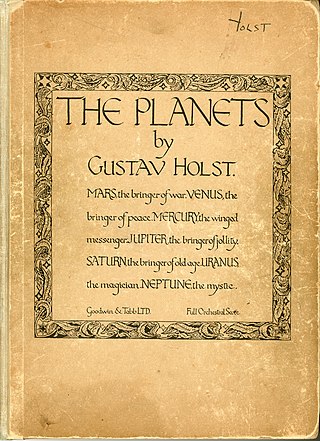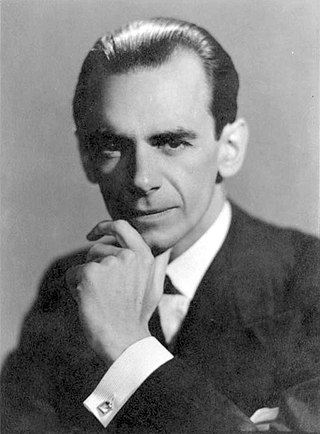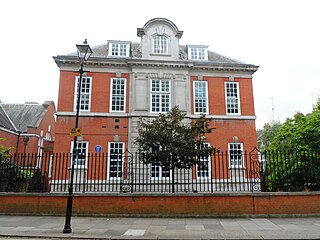Related Research Articles

Gustav Theodore Holst was an English composer, arranger and teacher. Best known for his orchestral suite The Planets, he composed many other works across a range of genres, although none achieved comparable success. His distinctive compositional style was the product of many influences, Richard Wagner and Richard Strauss being most crucial early in his development. The subsequent inspiration of the English folksong revival of the early 20th century, and the example of such rising modern composers as Maurice Ravel, led Holst to develop and refine an individual style.

The Planets, Op. 32, is a seven-movement orchestral suite by the English composer Gustav Holst, written between 1914 and 1917. In the last movement the orchestra is joined by a wordless female chorus. Each movement of the suite is named after a planet of the Solar System and its supposed astrological character.

Sir Adrian Cedric Boult, CH was a British conductor. Brought up in a prosperous mercantile family, he followed musical studies in England and at Leipzig, Germany, with early conducting work in London for the Royal Opera House and Sergei Diaghilev's ballet company. His first prominent post was conductor of the City of Birmingham Orchestra in 1924. When the British Broadcasting Corporation appointed him director of music in 1930, he established the BBC Symphony Orchestra and became its chief conductor. The orchestra set standards of excellence that were rivalled in Britain only by the London Philharmonic Orchestra (LPO), founded two years later.
The BBC Symphony Orchestra is a British orchestra based in London. Founded in 1930, it was the first permanent salaried orchestra in London, and is the only one of the city's five major symphony orchestras not to be self-governing. The BBC SO is the principal broadcast orchestra of the British Broadcasting Corporation (BBC).

Sir Henry Joseph Wood was an English conductor best known for his association with London's annual series of promenade concerts, known as the Proms. He conducted them for nearly half a century, introducing hundreds of new works to British audiences. After his death, the concerts were officially renamed in his honour as the "Henry Wood Promenade Concerts", although they continued to be generally referred to as "the Proms".

Sir Harold Malcolm Watts Sargent was an English conductor, organist and composer widely regarded as Britain's leading conductor of choral works. The musical ensembles with which he was associated included the Ballets Russes, the Huddersfield Choral Society, the Royal Choral Society, the D'Oyly Carte Opera Company, and the London Philharmonic, Hallé, Liverpool Philharmonic, BBC Symphony and Royal Philharmonic orchestras. Sargent was held in high esteem by choirs and instrumental soloists, but because of his high standards and a statement that he made in a 1936 interview disputing musicians' rights to tenure, his relationship with orchestral players was often uneasy. Despite this, he was co-founder of the London Philharmonic, was the first conductor of the Liverpool Philharmonic as a full-time ensemble, and played an important part in saving the Royal Philharmonic Orchestra from disbandment in the 1960s.

The Queen's Hall was a concert hall in Langham Place, London, opened in 1893. Designed by the architect Thomas Knightley, it had room for an audience of about 2,500 people. It became London's principal concert venue. From 1895 until 1941, it was the home of the promenade concerts founded by Robert Newman together with Henry Wood. The hall had drab decor and cramped seating but superb acoustics. It became known as the "musical centre of the [British] Empire", and several of the leading musicians and composers of the late 19th and early 20th centuries performed there, including Claude Debussy, Edward Elgar, Maurice Ravel and Richard Strauss.
Gordon Percival Septimus Jacob CBE was an English composer and teacher. He was a professor at the Royal College of Music in London from 1924 until his retirement in 1966, and published four books and many articles about music. As a composer he was prolific: the list of his works totals more than 700, mostly compositions of his own, but a substantial minority of orchestrations and arrangements of other composers' works. Those whose music he orchestrated range from William Byrd to Edward Elgar to Noël Coward.
Santiago de Espada is a concert overture by the Australian composer Malcolm Williamson.
Jean Pougnet was a Mauritian-born concert violinist and orchestra leader, of British nationality, who was highly regarded in both the lighter and more serious classical repertoire during the first half of the twentieth century. He was leader of the London Philharmonic Orchestra from 1942 to 1945.
Charles William Eric Fogg was an English composer, conductor and BBC broadcaster. His early works were influenced by Igor Stravinsky, though his later pieces owe more to Granville Bantock and Richard Strauss and even William Walton. Much of his music has been lost.
The English conductor Sir Adrian Boult was a prolific recording artist. Unlike many musicians, he felt at home in the recording studio and actually preferred working without an audience. His recording career ran from November 1920, when working with Diaghilev's Ballets Russes he recorded the ballet music, The Good-Humoured Ladies, to December 1978, when he made his final recording of music by Hubert Parry.
Dorothy Gertrude Howell was an English composer and pianist. She received the nickname of the "English Richard Strauss" in her lifetime.
Egdon Heath, Op. 47, H. 172, subtitled "A Homage to Thomas Hardy", is a tone poem by Gustav Holst, written in 1927. Holst considered it his most perfectly realised composition.
This is a summary of 1920 in music in the United Kingdom.
This discography is an incomplete, chronological list of recordings commercially released with the name British Symphony Orchestra on the label. The list also includes other known recordings which fall outside this strict definition: either because they have been included in published discographies of specific conductors under this name; or have been re-released as such on CD; or were never publicly released for general sale; or for comparison purposes only.

Hammersmith: Prelude and Scherzo, more commonly known as just Hammersmith, Op. 52, is a wind band work composed by English composer Gustav Holst in 1930. Commissioned by the BBC Military Band, the piece is based on Holst's love for the London borough of Hammersmith. The writing is more musically challenging than Holst's other wind band works, and is a wind band essential today. A typical performance runs for 14 minutes.
The Double Concerto for Two Violins and Orchestra is a work by Gustav Holst in three movements played without a break. It was written in 1929 and first performed in 1930 by its dedicatees, the sisters Adila Fachiri and Jelly d'Arányi. Though now praised by many critics, it has never been frequently performed in the concert hall. It is characterized by fugal counterpoint, folk-like melody, and bitonality without dissonance.
The Lyric Movement for viola and small orchestra is a short concertante work by Gustav Holst. It was one of his last compositions, being written in 1933. It was first performed in 1934, the year of his death, by its dedicatee, the violist Lionel Tertis, and the BBC Symphony Orchestra conducted by Adrian Boult. Though its early performers found the Lyric Movement too austere for their tastes, it has more recently been considered one of Holst's most successful later works. It has been recorded several times.
A Fugal Concerto by the English composer Gustav Holst is a short concerto in three movements for flute, oboe and string orchestra. It was composed and first performed in 1923. Influenced by the counterpoint of J. S. Bach, it is an early example of neoclassicism. Early reviews of the concerto were mixed, but it has since come to be seen as an attractive, if slight, example of Holst's neoclassical style, and it has been recorded many times.
References
- Holst, Imogen (1968). The Music of Gustav Holst (2nd ed.). London: Oxford University Press. ISBN 0193154161 . Retrieved 21 March 2024.
- Short, Michael (1974). Gustav Holst (1874–1934): A Centenary Documentation. London: White Lion. ISBN 0728500000 . Retrieved 19 March 2024.
- Short, Michael (2014). Gustav Holst: The Man and His Music. Hastings: Circaidy Gregory Press. ISBN 9781906451820 . Retrieved 19 March 2024.